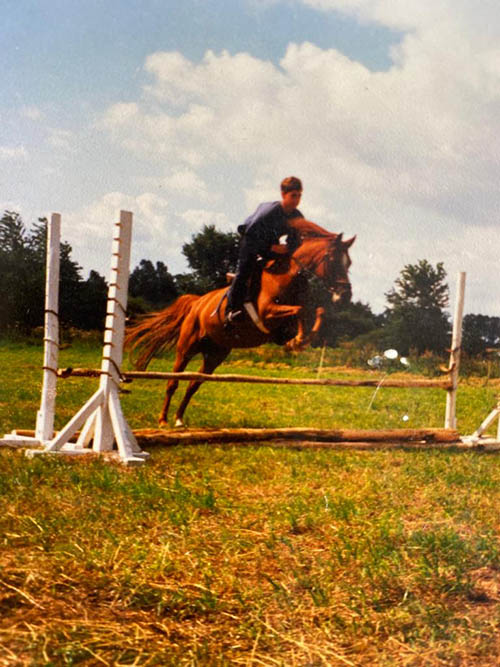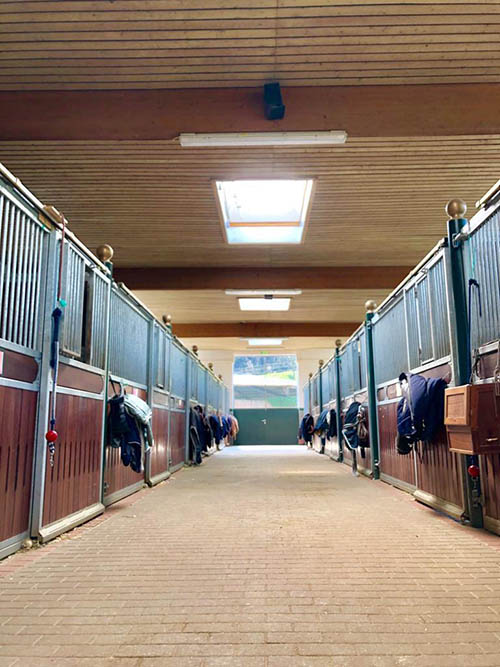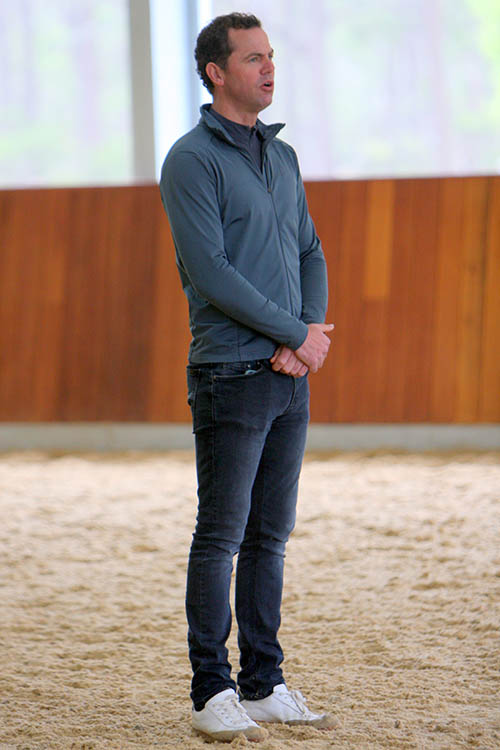Stefan Wolff is all about the absolute basics as was evident at his Australian clinic. Regardless of the level of the rider or horse, his principles apply with the aim to achieve the best possible outcome for each combination.

Stefan Wolff is no stranger to dressage coaching in Australia. He started coming to Australia and coaching at Clemens Dierks’s property at Dural, an hour from Sydney, 15 years ago. He was young and passionate and full of enthusiasm, with a very definite German overtone of striving for the best basics you can do and never lose sight of those principles. There was no use coming to Stefan if you wanted pats on the back and to be told all the good things about your riding and your horse. He was willing to give praise, but only when it was surely and honestly earnt.
Stefan’s challenge for a balanced, engaged and impressive frame, which was in true self-carriage, was where his eye was trained and he was not erring on any of the basics. There were no band-aid cover-ups, it was simply the honest, nitty gritty basics. He was somewhat humourless in his lessons back then, as it was business and not to be taken at all lightly. His empathy and feeling were wonderful and his aptitude to step on board and feel what the rider was dealing with was easy for him. He was impressive by correct and honest training and a man with an uncanny eye for balance. Having not been here for several years due to Covid, it was so good to see him gracing us again with his honesty and sending thirst for correct training.
Stefan was born in Lübeck in the north of Germany in 1979. Both his parents were passionate riders and owners and supported him and encouraged him throughout his working his way to regional junior and young rider dressage squads.
At 18, Stefan went into national service, which was mandatory at that time. He was one of the few athletes accepted to serve at the Sport School of the Federal Armed Forces and trained at Warendorf with Holger Schmezer, who was the German national coach. He completed his examination as a ‘Bereiter’ with distinction and trained with Klaus Balkenhol. He decided to go to university and in 2004 Stefan earned his law degree then went back to work for Klaus.
During his uni days he made the famous Rubins Royal to a good Grand Prix stallion. Whilst with Klaus he rode successfully at the Bundeschampionate and the FEI WBFSH World Breeding Dressage Championships for Young Horses. In 2006, Stefan passed the exam for Reitlehrer FN in Münster with a distinction and was awarded for the best Master-Examination in 2006. He then moved to Los Angeles and trained with USA Olympian Guenter Seidel and competed very successfully from young horse classes to CDI Grand Prix.
STUDYING BIOMECHANICS
In 2012, Stefan took up the position of deputy director of the Westphalia Riding and Driving School and worked with Martin Plewa, the then national eventing coach. His focus was to deepen his knowledge of the biomechanics of the horse and its use of its whole body in regards to a better balance. He gave many seminars about the training scale and the German system and was also appointed as one of the young rider squad trainers for the Westphalian Riding Association with great success up to the German Championships.


Since then, Stefan has established his own training operation first at Münster and now on a wonderful property in Hagen where, with partner Jye Thurgate, they run a very successful barn and dressage business. Jye is from Wagga Wagga in the Riverina area of NSW and started his career as a successful eventing rider. On moving to Germany, he completed his apprenticeship as a Bereiter and passed his examinations in 2021.
Jye has competed with good success in young horse classes and travelled to Australia with Stefan to conduct a clinic at the same time that Stefan was teaching. He is a very elegant and competent rider and coach. He is extremely passionate and thoughtful. Jye is exceptionally positive and honest when it comes to the futures of his young horses’ potential and has a great rapport with all horses and is a great communicator with clients and all those around him. He loves to ride and train and is always full of enthusiasm. He and Stefan make a great team and it’s no wonder they are so respected in the dressage fraternity.
At the Hagen property, there are 25 stables and an attached indoor arena, a walking machine and an undercover round yard. The 25 stables are always fun and Stefan is riding up to 10 horses a day. He has horses of clients that he competes and his own as well as horses that are there for sale. Stefan is also coaching a considerable amount and has some top riders under his guidance (including Grace Kay, a NSW squad rider). On the property there is accommodation for six staff or international riders who are there to train and compete.
Stefan admits he loves to compete and, as is always the way, he says that “when you finally get a horse competing and it’s good, often the lure of huge offers makes it hard for me to say no at this time in my life”. His enthusiasm for coaching is obvious and his ability to get aboard any horse and be able to feel the problems and work out a solution is quite amazing. He is a quiet achiever and a modest man to go with this.
Stefan is a thinker and a man of well-educated concepts that few coaches spend the time explaining and carrying through. He is all about the absolute basics… the simplistic art of balance… the ways to make a horse more comfortable mentally and physically. He is calm and precise and makes the techniques of riding an art. From low-level riders to Olympians, he is loyal to his eye and well-understood principles. No matter the level of the horse, or its ability by nature, his principles apply. He is simply relentless to the best possible outcome for each horse and rider’s ability with no shortcuts.


ALL ABOUT THE HALF HALT
Each coach has a particular theme or concept that holds the greatest attention, or key to successful riding and dressage training, and for Stefan it is the half halt.
The demystifying of the half halt has been written about ad infinitum. Before its use and ways can begin, before even delving in to the training of it, the half halt has a conglomerate of factors that influence the way it happens. The way it is introduced depends on the attitude of the horse. Lazy, forward thinking, backward thinking, hollow, too deep, hot, tense and even lack of tension, dull, sensitive, age and development of carrying power, simply to mention a few of the factors around the way a half halt is introduced, evaluated and put to use.
It is Stefan’s experienced eye, combined with an amazing knowledge of the horse’s anatomy and musculature – and above all his riding ability – that has given him the feel on so many horses under the watchful eye of many outstanding coaches and mentors. Stefan is the master of the half halt. He realises that it is the basis to being able to achieve a horse’s betterment in balance. With this better balance comes honest self-carriage and ease of all movements required in a dressage horse at all levels. No exceptions.
There are many factors that need to be instilled in the training of the horse before a half halt can be processed. Of course, the horse must react. He must move forward and he must come back from the rider’s aids. He must have the concept of straightness, being on the bit, and he must have a body that is muscularly ready to accept the changing of the balance over the hindleg.
The first hint of a half halt, or change in balance, is a downward transition, so this starts from day one under saddle. Any downward transition should create that feeling of bringing the horse over the hindleg or the hindleg under the horse, as opposed to a downward transition leaning forward into the bit and pushing the forehand into the ground (transferring weight but totally the wrong loading). The horse must always stay attentive to the bit and not lean and push forwards with the neck and shoulders.
There were many, many points that Stefan made in relation to putting the half halt together and some of his musings may resonate with the thoughts in people’s minds about the concept and the way it works.

PUSHING OFF THE GROUND
Stefan explained how it’s important to get the horse to push up off the ground. The more push off the ground, the more expression. It is like the bouncing of a basketball so you generate energy off the floor. The harder you push at the floor, the bigger the rebound. It’s an up and down feeling. It’s not like a tennis ball hitting a racquet and shooting off.
The horse must be always moving through their body and the rider’s hands must stay dynamic with the contact and the neck. There is no place in dressage for still or stubborn hands; they should always be dynamic with the horse’s neck.
Once you have made a half halt, do not drive immediately forward but use that balance to push upwards off the floor (reference to an Advanced horse that is quite forward of his own volition). The half halt should be very brief and not held on to. Once the balance rocks back, the LIGHT forward contact without the horse running away – the basketball bounce! Move the body against the ground. When it’s time to use the half halt, be decisive. Use it, don’t hold, be quick and release; if the balance falls away, repeat but never hold. You need to make a decision to make the half halt. Make it quick and lighten. If you overcorrect then you will be riding the horse out of balance.
In the half halt, the hands do not become still. They become part of the dynamic of the topline. The mouth and the neck should be mobile. It’s harmonious and natural. The half halt is never squishy-squashy but definite, quick and brief.
With the lazy horse, you must get a reaction to the hindleg, and if a tap with the whip is required then do what you have to do to get a reaction. He shouldn’t try and escape but continue until the reaction goes in the correct way.

“Don’t look for great collection
but for more dynamics.”
REFRESH THE MOVEMENT
When the horse becomes dull and sluggish in the contact, you then need to awaken the horse’s body so you can raise the base of the neck and refresh the movement. When the horse pushes the mouth to the ground, you must keep the activity. Never give the horse the privilege to hold on to you but keep the hands dynamic of the movement. The horse gets tired if you take too long and nag in getting it to move the balance over the hindleg. Be quick and brief and get the adjustment. They will only get tired if its prolonged and leaning.
If you find the half halt attainable in the trot but foreign in the canter, imagine you are trotting and apply the same indications and principles. In the canter, half halt when you get the reaction, be light in the reins and allow him to develop the push off the ground. Don’t look for great collection but for more dynamics. The neck must grow bigger after the half halt. Fill up the contact and stimulate the neck. Do not pull at it. Be dynamic and again, there is no place for dead still hands.
If you put too much bend and flexion in to the horse, you will lose the pushing power. This is not what you want. The half halt increases the carrying power, not the pushing power. The horse must jump in to the centre of the bit, with not too much flexion or you will lose the power.
If the horse holds against you then keep the legs moving and get them to move the body and push off the round.
In the shoulder-in, take the rider’s inside leg towards the wall.
In the leg-yield, be careful not to push the outside hindleg out as you will lose the power and the impulsion. Do not let the horse get too much bend and flexion as the drive sideways will decrease the pushing power.
The short side is the most important as this is where the judges get to see the silhouette and the balance.

“There must be positive tension to
develop the activity.”
CONVEX OUTSIDE, CONCAVE INSIDE
On circles of all sizes and corners, be careful not to be restricting with the outside rein. The horse’s body on the outside of a curved line has to be longer than the inside of the body. Convex on the outside and concave on the inside. The outside hind and the outside foreleg have to cover more ground. The outside rein must direct the forehand but also the bend. Too much flexion makes the outside hindleg drop short; straighter allows the outside leg to follow and stretch around the line.
In the trot-to-walk transition it is imperative that the horse keeps the activity in the collecting to the walk, and then that activity through the horse’s body must stay there in the walk. Do not lose the positive tension within the horse’s body in the walk. The walk should not be restful. Make transitions almost to walk and then out. Do not let the horse shut down and keep the activity and the positive tension. If the tendency is to shut down, be aware not to suffocate him with the aids.
With the younger horse that is a little dull, he must think forward, but the rider must not be always chasing him as this will only make for a duller horse.
In the halt there must be the same energy as there is in the trot, walk and canter and he must stay energetic through the body even though he stands motionless.
In improving the canter it’s not always the forward, it’s the sitting back and working at pushing up off the floor. There must be positive tension to develop the activity. There must be a feeling that the aid creates a snap in the muscles, not an elongating chasing feeling. If the horse falls out of canter, use the whip to create the activity and do NOT chase it. The whip on the croup creates an activity, and then let him come back to the impulsion.
Don’t always work in the comfort of the middle ground stretching and collecting. Widen the range. Use the whole scale from 1 to 10, not just the middle ground.
With tight, stiffer horses always work from the inside of the horse to the outside and let the horse fall on to the hindleg both backwards and sideways.
When starting canter engagement and pirouettes, there is very little to no flexion and keep the gullet on the outside closed, otherwise the drift out with the hindleg will not allow him to get the power. Also, keep the neck a little deeper to help the horse stay through and over the back. The half halt will then go through the body on to the hindleg. Too much flexion and you lose the control of the outside shoulder. The horse must feel he wants to move to the inside rein and think that the end steps in the pirouette are the ones you want in the beginning.
Do not fiddle more than you feel!
Stefan’s coaching sessions were full of wonderful and simplistic ways to make what can be complex and complicated easy. The man is a passionate and positive trainer with empathy yet determination to see improvement and the grasping of the concepts for rider and horse. There is no room for covering up flaws. There is no use blundering on without an adjustable and balanced horse that can make the work look and be easy. Stefan was easy to listen to and understand with calm and compassionate consideration. EQ
YOU MIGHT ALSO LIKE TO READ BY ROGER FITZHARDINGE:
The New Novice Tests – Equestrian Life, February 2023




